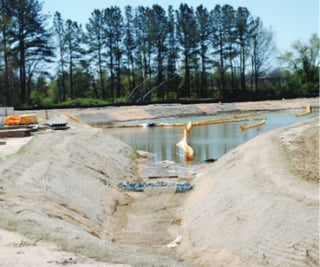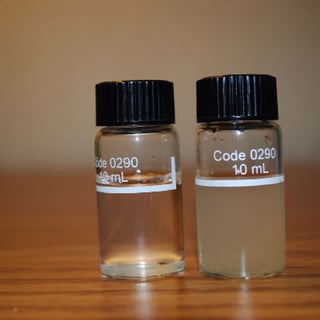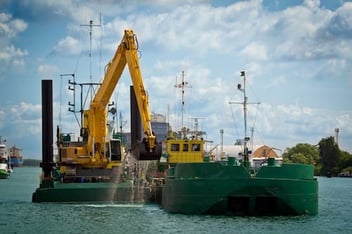Bag of Tricks
Dual-Polymer System Treats Construction Stormwater Runoff, Reduces Sediment
By Mitchell Stocki

The construction of a new Wal-Mart located in Denton, Md., included the installation of an award-winning stormwater bioretention system that uses landscaping and natural treatment processes to ensure water quality at the site -- the first of its kind to be built in the United States.
RIV Construction was awarded a $16.6 million contract to construct the new superstore, sized at nearly 153,000 square feet. On-site development of the 16.6-acre property comprised demolition of existing buildings; substantial earthwork; installation of all utilities, sanitary sewer and storm systems; complete concrete and paving work; installation of guide rails and fencing; and landscaping, including retaining walls.
In order to properly transfer stormwater from the construction site, the project included a large retention pond.
The project, however, received much public scrutiny given that a creek, which served as a prominent water resource, flowed in close proximity behind the site.
In order to properly transfer stormwater from the construction site, the project included a large retention pond, and effluent was discharged into an adjacent creek via a stormwater culvert. Unfortunately, the treatment plan enacted for the rainwater wasn't working, and RIV faced fines of $10,000 per day or complete project shutdown until the NTU compliance requirements were met.
Problem: Turbidity
The Maryland Department of the Environment (MDE) initially inspected the project, but the results of the report were unfavorable. At the time, RIV was treating the stormwater runoff with anionic polyacrylamide (PAM) logs and was not meeting the 150 NTU level required by the state of Maryland.
The sediment program enacted in Maryland in 1970 focuses on minimizing turbid runoff from construction sites, given that almost all residual drains into the Chesapeake Bay. As such, all new development must meet certain specifications for runoff control, and anything over 5,000 square feet must have a sediment control program submitted and approved.
"In the case of this project in Denton, the groundwater levels were high -- about 3 feet below the surface. Due to this, we had to over-excavate the site and put in stone," noted RIV superintendent John Raum Jr. "Also, right behind the site, there is a retention pond for a sewage treatment plant about 10 feet higher than the Wal-Mart site. Add to this the sandy and clayed soil as well as the site being located about one hour from the ocean and Chesapeake Bay, and water was quite a problem."
By running discharge water through HaloKlear DBP-2100 and GelFloc socks, RIV Construction was able to reduce the turbidity of affected water by 1,600 percent.
The original plan entailed utilizing a pond to collect rainwater before it left the system, where gravity allowed the sediment to fall; however, the method was inefficient. "As the pond was designed to drain into a nearby creek, we had to block it off until we had no sediment in the discharge," noted Raum. "While working on a better solution, we confined it with a rubber ball in the pipe and a piece of plywood staked against the opening. This was mid-January, and the spring rains were right around the corner."
Accordingly, the construction group needed to control NTU levels of effluent stormwater leaving the water basins into a nearby creek. After using an anionic flocculant log product and jute matting with little to no effect, RIV employed a dual-polymer product by HaloKlear recommended by Keith Martin of Hanes Geo Components.
"The Chesapeake Bay is a very sensitive body of water under incredible public scrutiny," said Martin. "Although PAM products can be very effective, if you use the wrong one, the runoff will kill fish, and if the user doses the stream or basin too heavily, it can kill downstream. Having options is important for construction companies in this area."
Solution: Dual Product

HaloKlear's Dual Product system is an eco-friendly, all-natural flocculating treatment suited for handling stringent government compliance standards and returning water to the environment safely and well within regulations. The system consists of dual-polymer socks; a small weir and mixing chamber; a sediment bag; and excelsior blankets for small particulate capture escaping the sediment bag.
RIV applied HaloKlear DBP-2100 and HaloKlear GelFloc socks to two nearby stormwater basins. Influent stormwater contained 700-900 NTU, averaging 862 NTU. After the applied dual-product treatment, effluent discharge averaged 5.35 -- well below the 150 NTU threshold mandated by MDE.
The Dual Product System is both anionic and cationic and uses polysaccarides (crumbled crab shells), and the anionic agent is a thickener used in foods. The product is stored in a sock and is placed inside the pipes: as the water rushes through the pipes, the polymers dissolve. Dewatering is processed by an absorbent gelling material, which in this case was provided by Hanes Geo in the form of a dewatering bag.
Moreover, water is pumped through the manifold system and into a sediment tank with a filter tank. The HaloKlear product then makes the residue flocculate, or bundle together, and water is passed through the tanks and into a silt bag, producing treated water. "The final silt bag may not have been needed, but we wanted to be sure," noted Raum.
The replacement of the anionic floc log with DPS MB kits enhanced the water quality in the existing stormwater pond and eliminated the possibility of competing chemistries when treated through the manifold optimizing floc characteristics within the sediment bag.
The manifolds pumped water through the sediment bags and transferred it across treated excelsior blankets and into the discharge basin. Following the success of HaloKlear DPS treatment in the first basin, the contractor deployed another system for future treatment in the second basin. It was determined that the results would be enhanced by increasing the sediment bag and channel footprint.
The HaloKlear DPS manifolds pumped water through the sediment bags and transferred it across treated excelsior blankets and into the discharge basin.
With a larger sediment bag on or near level ground, the water treatment system enhanced performance and reduced maintenance. The channel was also lined with heavy plastic, and the sediment bag rested on an excelsior blanket folded three to four times on itself. This allowed for water percolation and the capture of fine particles escaping the bag.
Increasing channel footprint and decreasing pitch kept fine particles from escaping the bag to be captured in the excelsior blanket. Additionally, three rock-check dams at equal distances slow velocity, keeping the fine particulates in contact with the filtration media.
Conclusion
By running discharge water through HaloKlear DBP-2100 and GelFloc socks, RIV Construction was able to reduce the turbidity of affected water by 1,600 percent, averting the risk of governmental fines, saving on operating costs and adhering to the projected schedule. Today, the completed project utilizes a large stormwater system buried beneath the store's parking lot.
This article is reposted from Water World. View the originial article here: http://www.waterworld.com/articles/iww/print/volume-13/issue-6/columns/bag-of-tricks.html



